Luang Prabang
Arrive at nightfall in the town of Luang Prabang. Our hotel awaits us on a quiet side-street. Polished wooden floors and wooden stairs gleaming within and a pleasant little outdoor area in front with chairs and pinkish flowers on tables. Welcoming sort of place. A tidy walk from the centre though. Several of us amble off up the lane past other small hotels and turn right on the main avenue in pursuit of supper. We investigate a large outdoor food market where the populace are noisily enjoying themselves accompanied by foodstuffs and liquid refreshment. Mosey up to one stall and scan the bill of fare. Not enticing. Decide against. And anyway, the benches are hard.
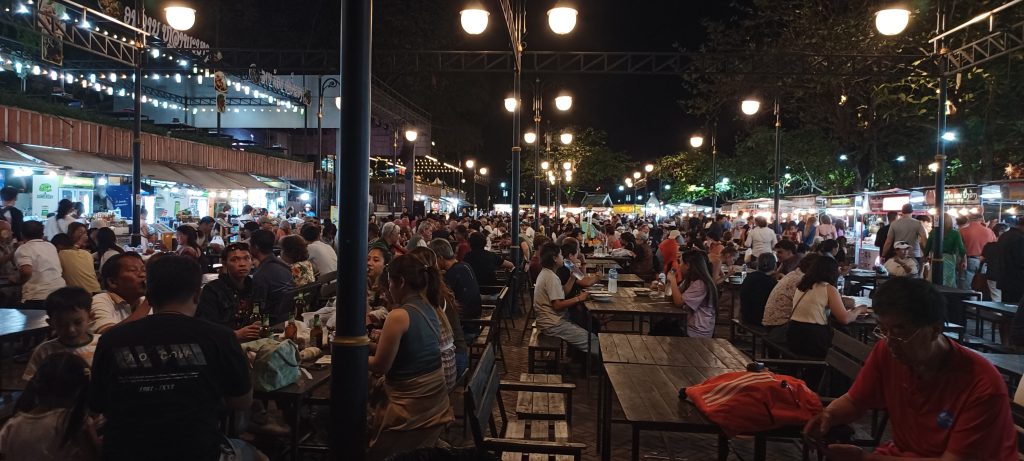
Continue through the night market, a long pedestrianised street lined with souvenirs on the ground: stuffed elephant toys, elephant patterned trousers, bags, jewellery, paintings on strips of canvas, local textiles and ethnic handicrafts as we have seen elsewhere. And T-shirts and lamps and wooden elephants. Only actually seen one live elephant, I muse, since being in Laos and that one was standing on the Mekong’s edge as we floated downstream on the boat.
Alongside the night market is the splendid 18th century Wat Mai (New Monastery), glowing in the flood lights. A very important temple, I understand, and the largest in the city. Fountains twinkle, king cobras (known as nagas) – not live ones – guard temple entrances.
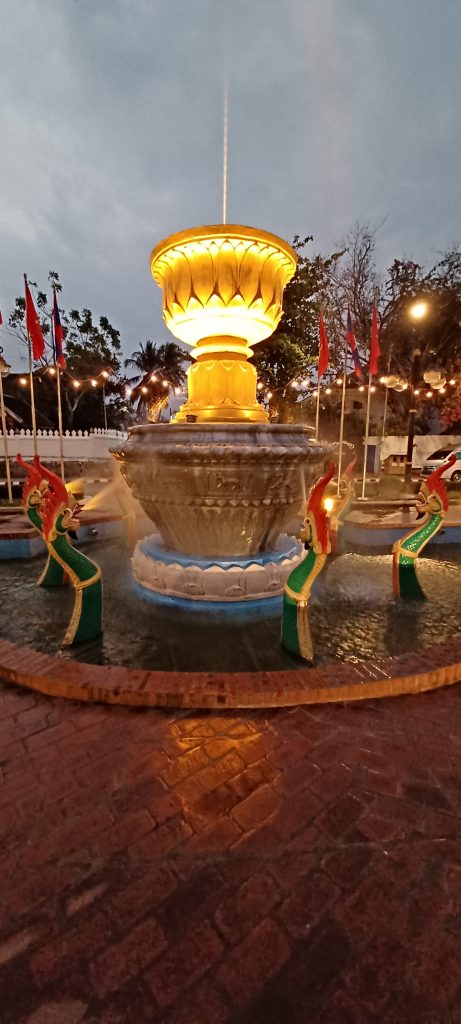
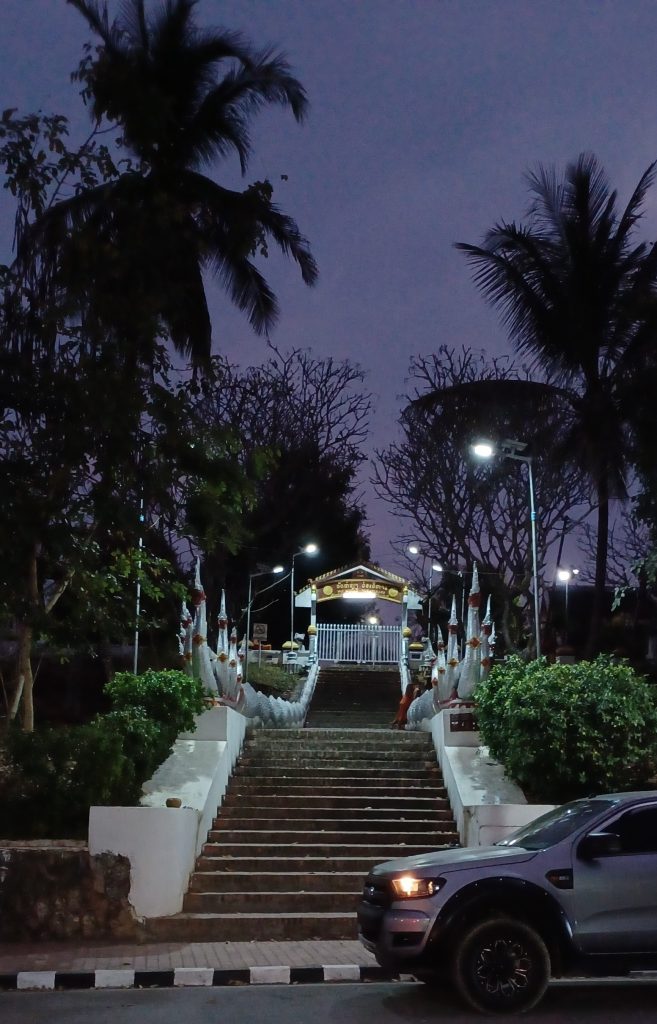
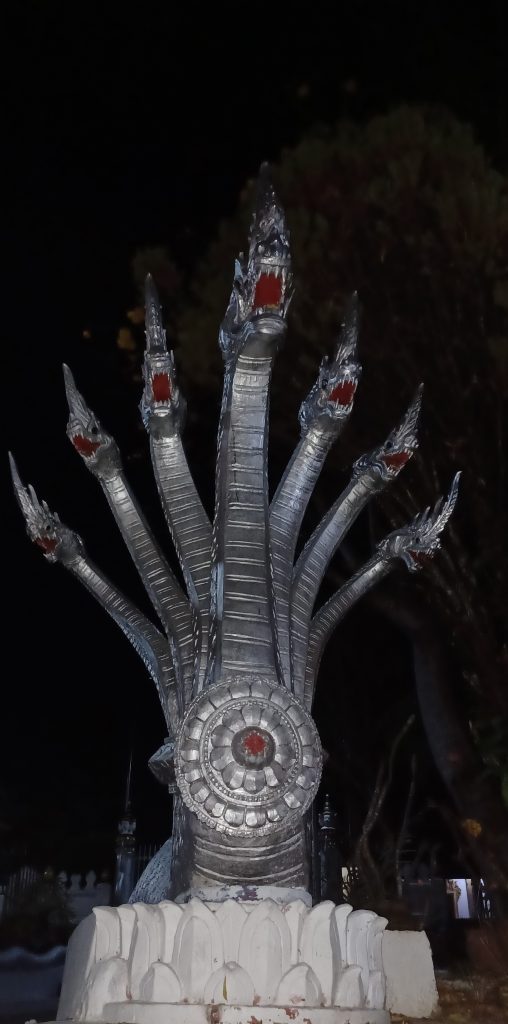
Eventually find an attractive establishment in which to dine, with stripy tablecloths, and long streamers, ferns and lamps dangling from the ceiling. Settle down against comfy cushions and order. This is more like it. Jolly atmosphere. Somersby apple cider is on offer! Rejoice. An amiable looking chap conveys a large glass to the table, and empties a large bottle into it. An unanticipated beverage in Laos to be sure. Maybe the French introduced it. To accompany the cider some bland fried rice served with pork, tomato, lettuce and cucumber slices. OK. Thus sated, we wander back through the night market, the food market with its diminished number of revellers, the still twinkling tinkling fountains and floodlit temples to the quieter street of our hotel.
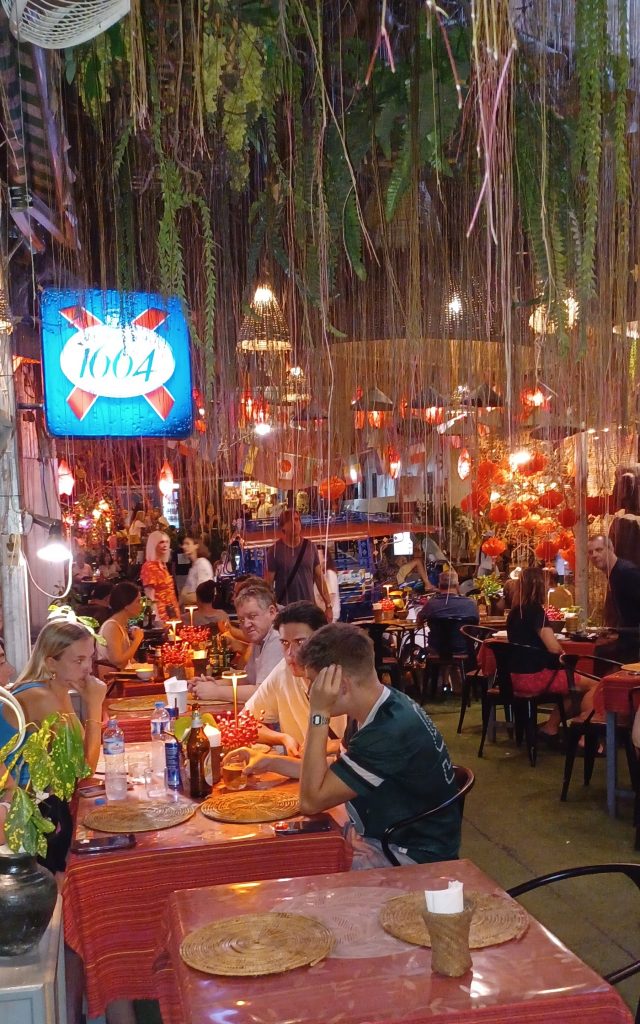
Luang Prabang was designated a UNESCO World Heritage Site in 1995 on account of its numerous golden Buddhist temples. With this UNESCO status, the town is obliged to preserve its historic buildings and cultural activities, including religious rituals, and to restore buildings which have fallen into disrepair. There is an obligation too to protect its wetlands, river banks and other natural areas. The architecture is a mix of traditional Lao and colonial 19th/20th century European. Luang Prabang is one of the oldest towns in Laos, having been here for more than 1,200 years, and is sited at the confluence of the Mekong and the Khan rivers. The town perches on a peninsula between them. A sacred mountain stands in the middle of this peninsula named Mount Phousi.
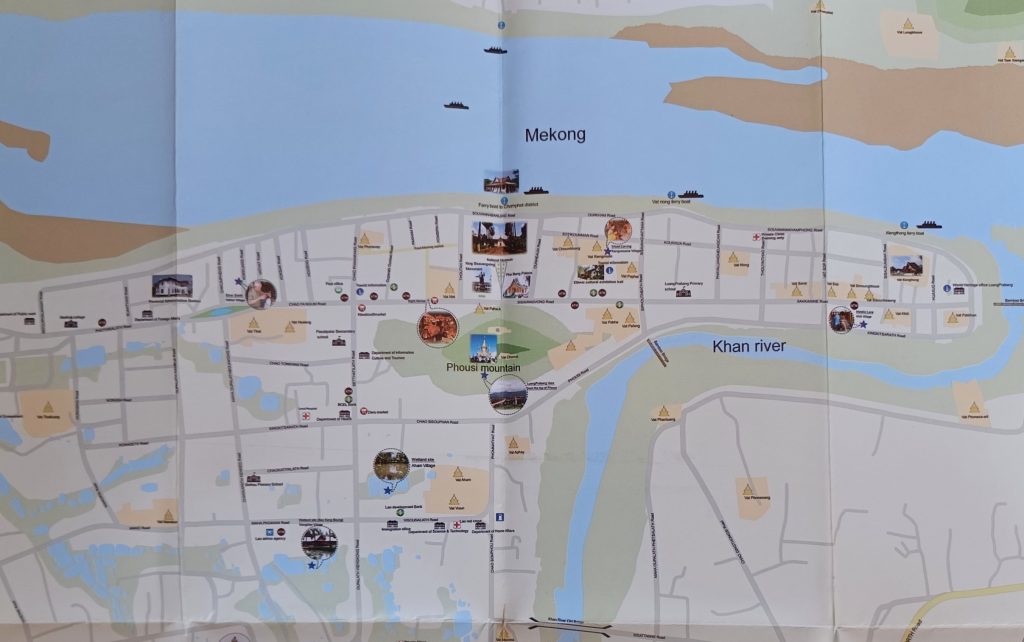
In the mornings at 0530, hundreds of monks in their saffron robes walk through the town to collect alms. This ritual is known as Sai Bat. Onlookers donate sticky rice. Nobody speaks apparently. I had been invited to witness the scene but was unable to arise at the appointed hour. Anyway, many Buddhist temples adorn Luang Prabang. Thirty two of them are protected by the World Heritage status and there are at least another fifty along with about a thousand monks. The city’s name, Luang Prabang, derives from the 14th century Buddha statue, the ‘Pha Bang’, which resides in the former King’s palace, now the National Museum.
Shame I missed the 0530 ritual. Never mind. Plenty to see here in the town. Day of freedom too. Our cheerful CEO had tried to allure us onto a day trip to see the sites of Luang Prabang but most of the group feel they want to wander at will. Anyway, a city tour should be included in the price of the tour, in my view, rather than an optional extra to be paid for. Feeling a bit jaded with the guides in general too, including the myriad ones we had in Thailand. Keen to flaunt their prodigious knowledge, their listeners are seldom left with enough time to read any information provided, or view any items closely. An example being when the guide preaches in front of some exhibit or other while fifteen participants are struggling to gain a view of it, most trying to take photos, as well as understand what is being said. The Lao people tend to leave out consonants when they speak English. Thus ‘five’ becomes ‘fi’, ‘guide’ becomes ‘gi’. Blink and you can miss the meaning.
National Museum
Therefore, I wander off with others at 0930 in the direction of the National Museum. Takes a while. But eventually we enter the grounds. Immediately to the left looms a large five tonne statue of King Sisavang Vong – a gift from the Russians, cast in 1975. It was he for whom the French built the Royal Palace in 1904. A significant figure in shaping Lao history, he initially supported French authority in Laos and ruled as monarch for 55 years, but finally gained Laos’ independence from France in 1953. Looks a commanding sort of chap. He holds one palm upright facing outwards like a Buddha pose. A sword by his side and chest covered with military medals, one of which must be the Croix de Guerre, awarded by the French. Not clear how many wives he had – somewhere between ten and fifteen – and fifty offspring. After his death, the Crown Prince occupied the palace but the communist revolution in 1975 put paid to Lao royalty and the government took over the palace and converted it into the museum we see today.
Opposite King Sisavang Vong is the stunning and sacred Buddhist temple, the Haw Pha Bang. Gorgeous roof in five tiers. This temple is supposed to be housing, in a special gilded altar, the Pha Bang, the venerated gold Buddha image, which is a symbol of Lao sovereignty. The statue was captured by the Siamese twice but returned by King Mongut in 1867. Anyway, at the moment the probably 14th century old Pha Bang is in the National Museum building, to which I now head.
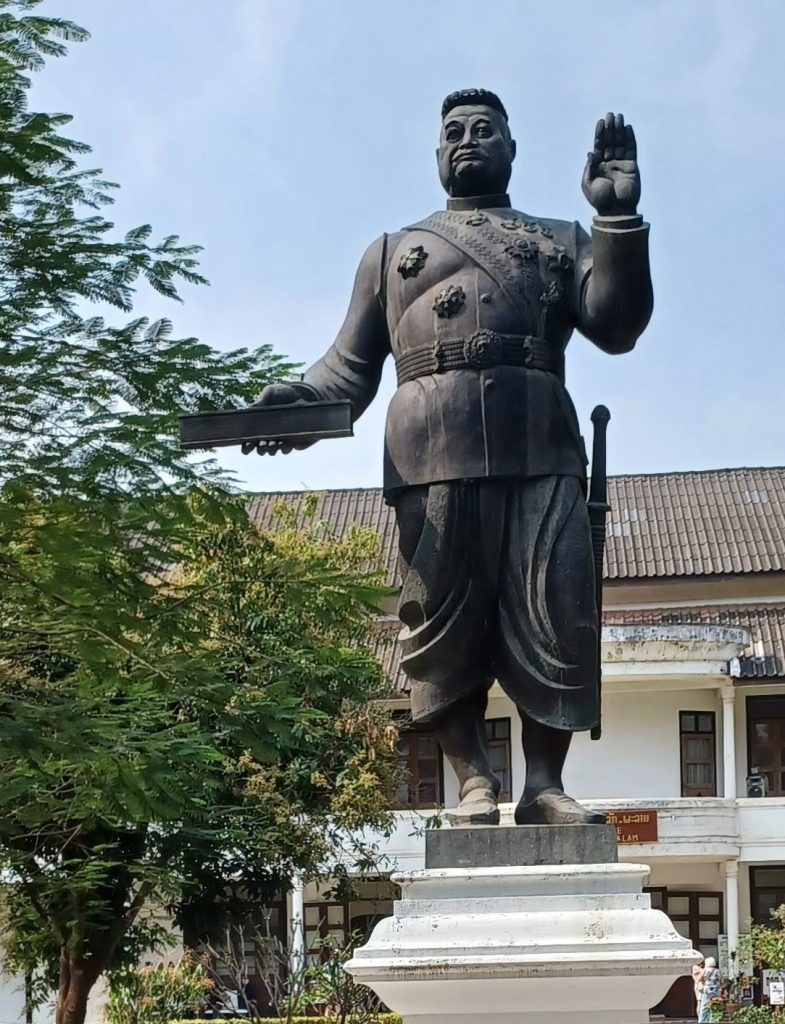
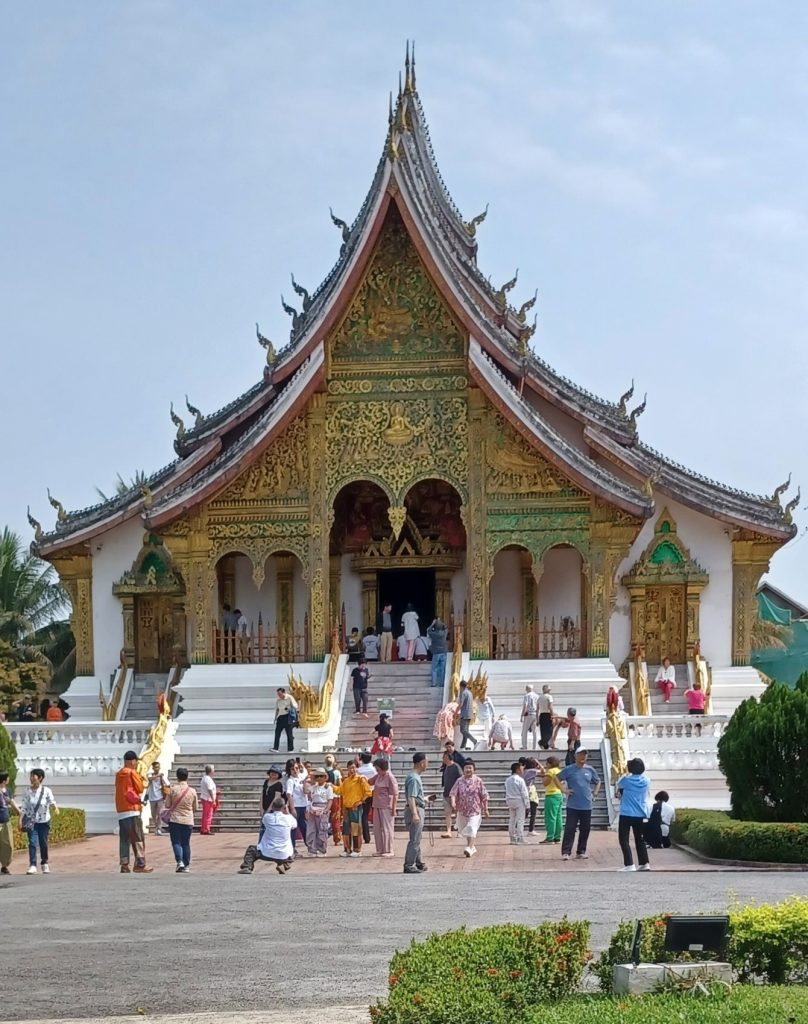
The National Museum contains artefacts and gifts, especially from China and France, of great cabinets, swords and helmets, plus forage caps – which the last King once wore on official business. There are spacious reception rooms for dignitaries, throne room, the King’s and Queen’s bedrooms, intricate mosaics on red walls and an attractive room covered with murals depicting the temples of Wat Xieng Thong and Wat Mai with their graceful palm trees and worshippers. Also within the palace, as before mentioned, is the Pha Bang. At least, I think it is. I don’t get to see it. Not huge at 83 centimetres tall but made of a precious gold, silver and bronze alloy. No photographs allowed.
As I wend my way towards the exit, I wander by a large sacred pond in the grounds once worshipped by Royal Family members. Name is Theungketh Pond. A serene spot in which to linger for a spell.
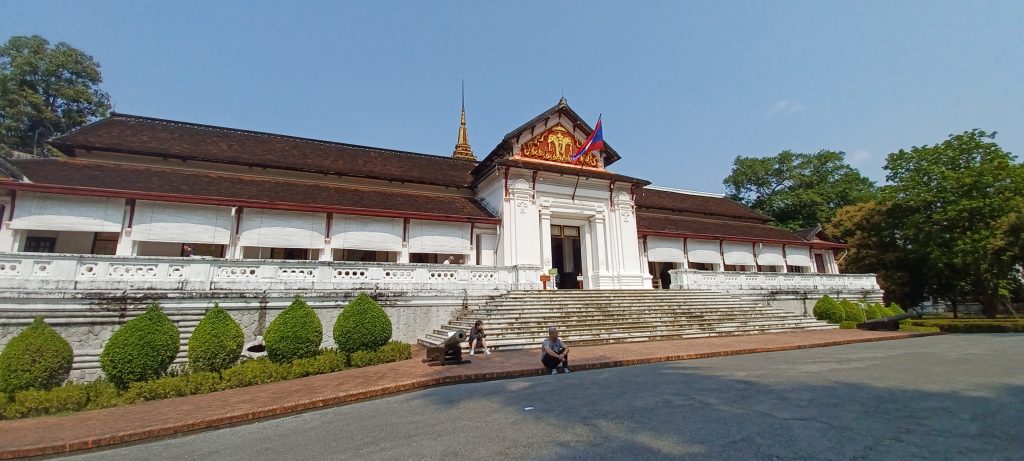
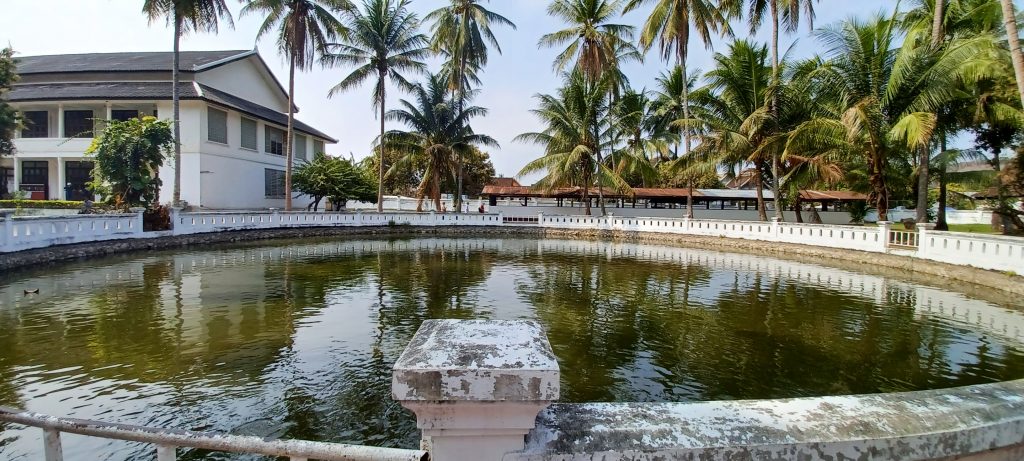
Wat Mai
Thence to continue exploring. A short distance from the National Museum is Wat Mai, or Wat Mai Suwannaphumaham, to give the temple its full name. This is the temple we saw in the floodlights last night. At one time, the Pha Bang was hosted inside – until 1947 – and is borne back here annually and with suitable ceremony during Lao New Year. There to be displayed for three days and ritually sprinkled with water by worshippers. Another beautiful five tiered roof tops the temple with golden nagas on the finials. The Chinese ransacked Luang Prabang in 1887 but this temple was spared from destruction apparently. I remove my shoes, enter its veranda and marvel at the gilded relief across the wat’s front wall. It depicts scenes from the Ramayana, one of the two epic Indian poems, I understand. I saw scenes from this poem in the Grand Palace in Bangkok (see Thailand, Part 1: Bangkok). Inside, it is all dazzling red and gold columns and gilded Buddha statues. One or two monks wander about.
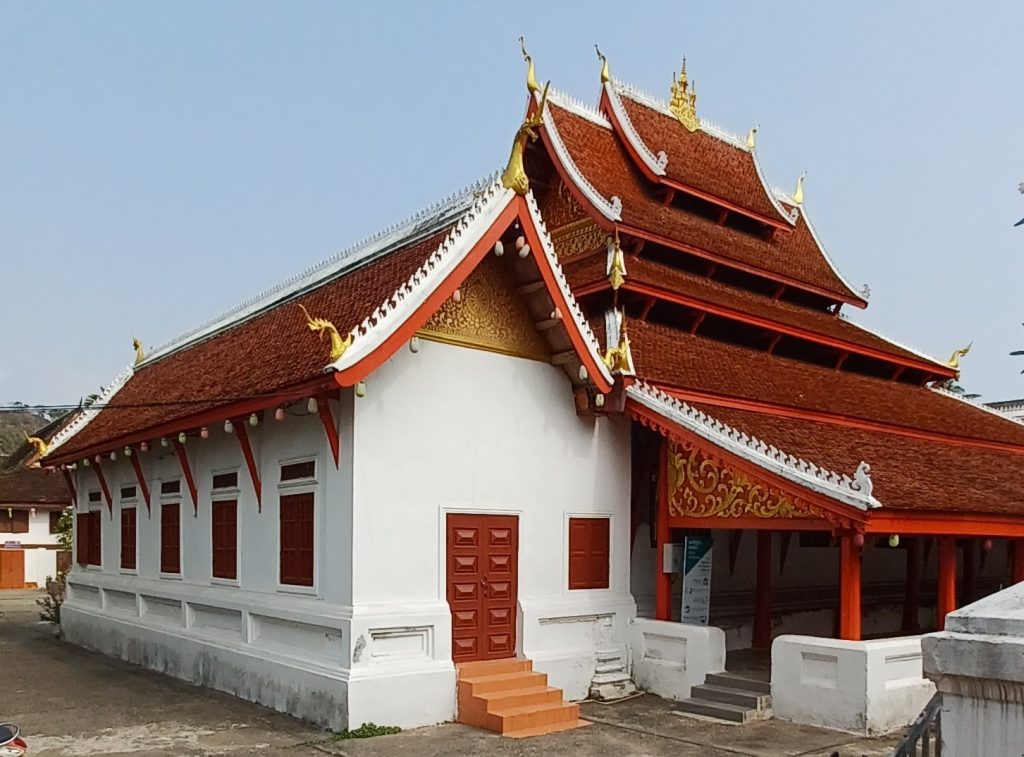
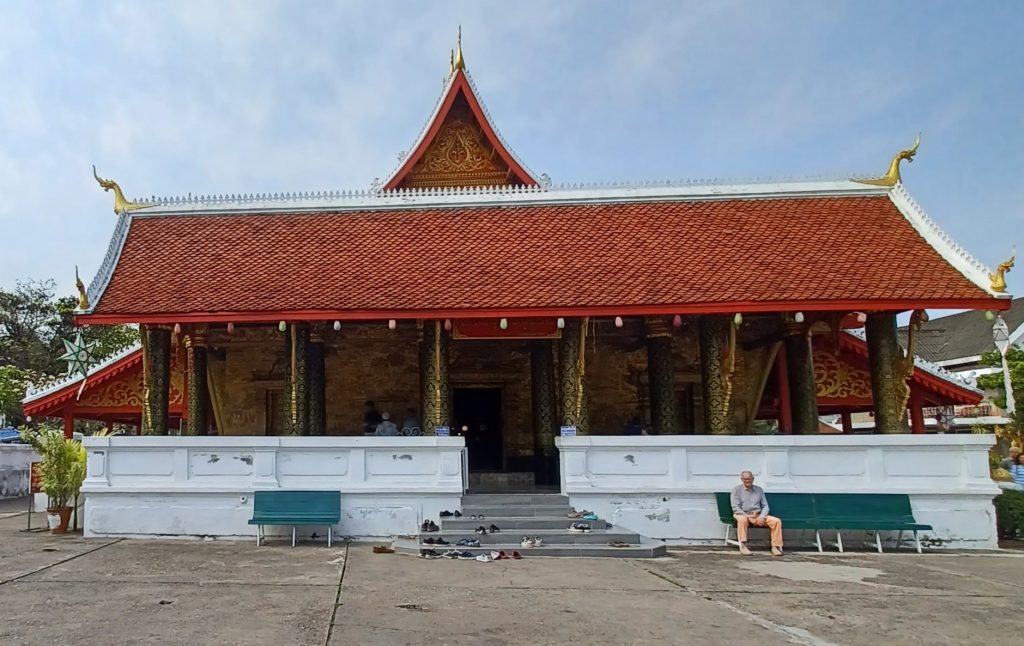
Thence, I wander off on my own and admire the less ravishing but still lovely old French colonial buildings along the streets. Tuk-tuks and buses and motor bikes and frangipanis and palms and cafés and restaurants all along the river frontage, and notices advertising river trips at sunset.
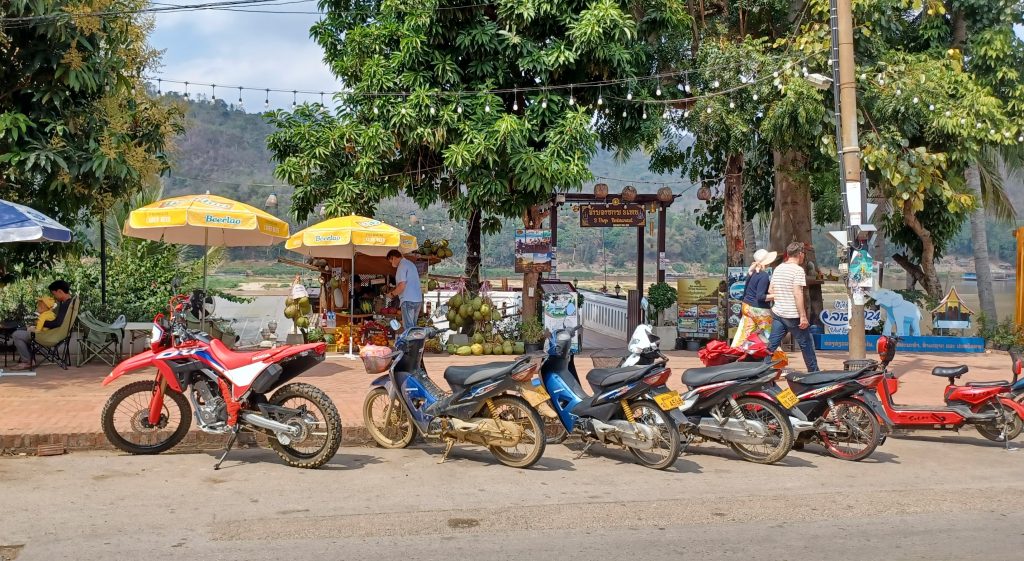
Need a drink. Venture down some stairs into a café. The electricity has gone off, I am told, so no juices are available. Eh? OK. Go into next café. The proprietor here cannot produce fruit juice either due to the lack of electricity but can produce coffee. Can’t work that one out. “With milk please”. Coffee arrives in a tiny glass with yellowish stuff – condensed milk – in a separate glass alongside. Haven’t had condensed milk in coffee since my early trips across west Africa in the 1980s. Grimacingly sweet. Brings back memories.
Rested and refreshed, well sort of, I take a few steps down to the river. Some boats are fooling about here. Car ferry too, crossing to the other side, and a boat taking tourists to the Pak Ou cave where we stopped on our Mekong River trip (see Laos, Part 1).
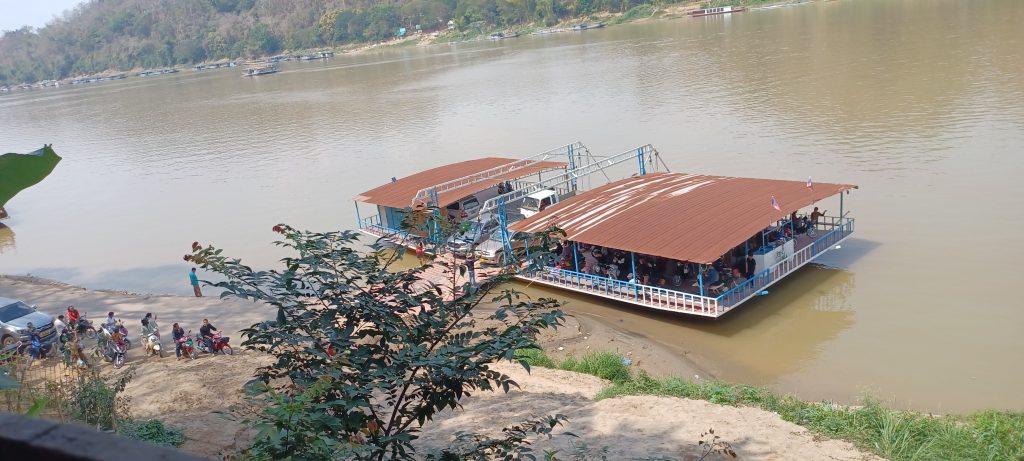
Wat Xieng Thong
My aim now is to visit the famous and magnificent temple, one of the most important in Laos, Wat Xieng Thong. As with Wat Mai, the temple survived the damage done by the Chinese in 1887. Built in 1559, it was the traditional site for the coronation of Lao kings and is the focus for many festivals honouring Buddha. It is a living working temple housing many monks and is situated at the head of the peninsula where the Khan river flows into the Mekong.
It is hot. I am plodding along pondering how long it will take to get there. Midday sun. Mad dogs and Englishwomen. See a bunch of tuk-tuks and tourist buses. Must be close by. Plod up and down a road, turn left, turn left again. Find it. Finally. Phew. Not much information here in English, unlike the National Museum. Pity. But exquisite buildings. Wat Xieng Thong translates as ‘Temple of the Golden City’. Not without reason. The buildings are adorned with golden mosaics, murals, wood carvings and golden Buddha statues. Graceful architecture featuring sweeping rooves in three tiers.
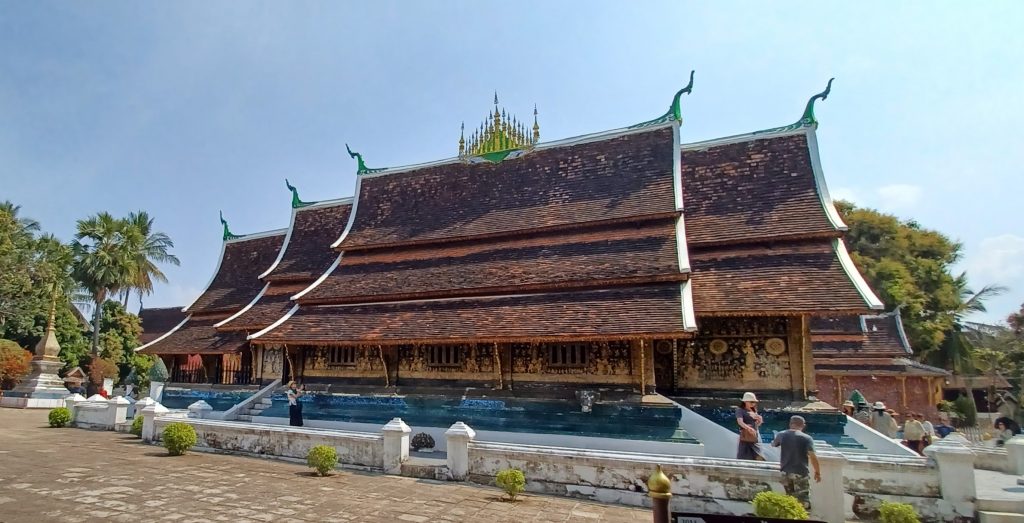
During my wanderings I enter the Carriage House containing relics of King Sisavang Vong, who died in 1959. The golden carriage within took the coffin to another temple, Wat That Luang, for cremation I understand. Pulled by seven golden nagas. More Buddha statues. I wander around the temple precincts for some time amongst the palm trees and bougainvillea, a boat house, and shrines.
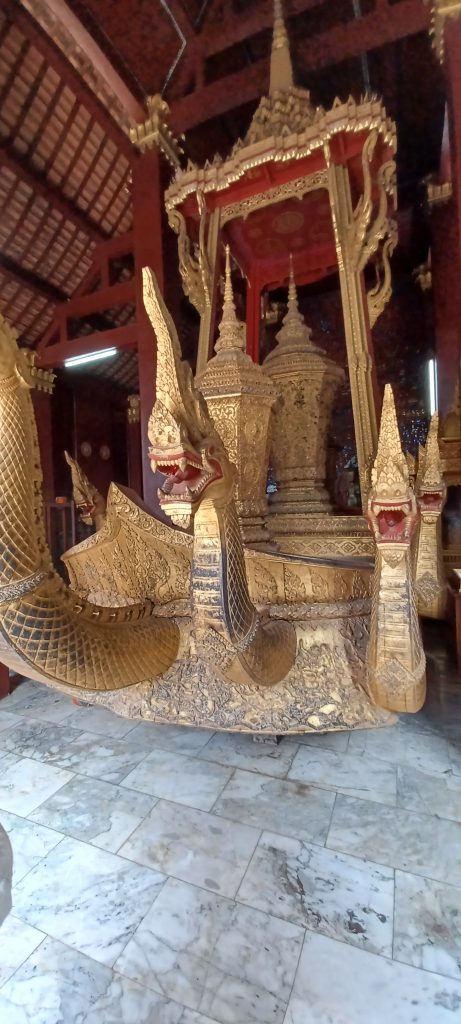
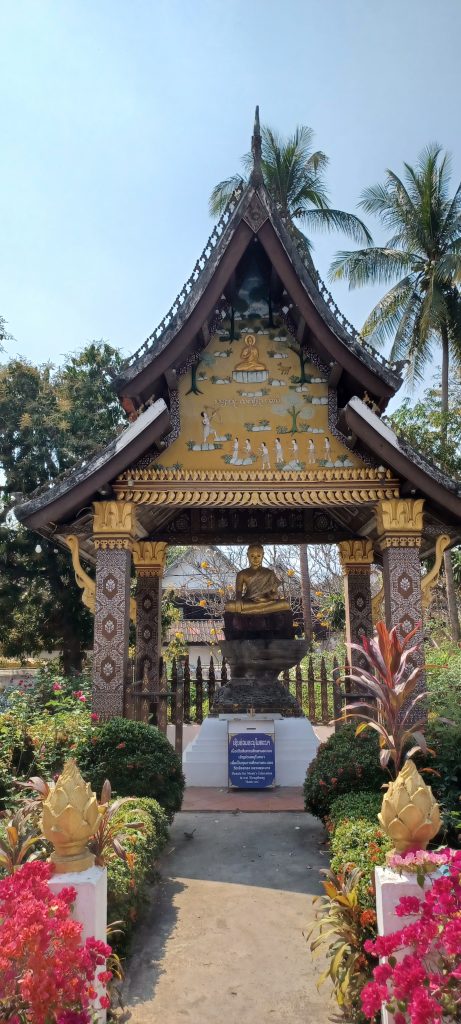
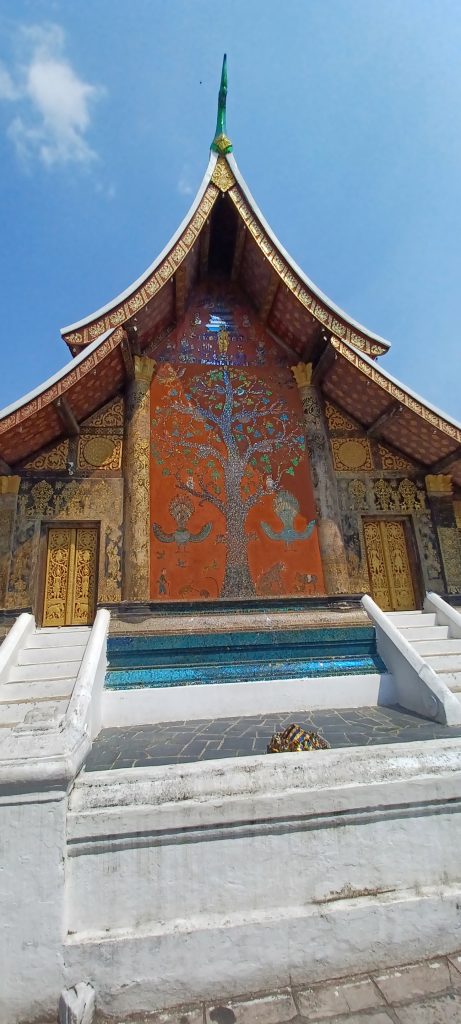
I am now hungry and thirsty and perspiring profusely in the steaming stillness. Close by is an enticing restaurant overlooking the confluence of the two rivers. Mopping my brow, I enter its welcoming veranda, which is shaded with giant sunshades and dotted around with luscious pot plants. Settle down at a teak table and order mango juice. Plenty of ice. Once cooled down somewhat I can take in the surroundings. Pleasing on the eye, and balmy and restful but for a group of Australians talking very loudly at a corner table. A large vessel, a dredger I think, turns up on the confluence as mine host delivers lunch. Eye it between mouthfuls. Take my time. Other clientele come and go.
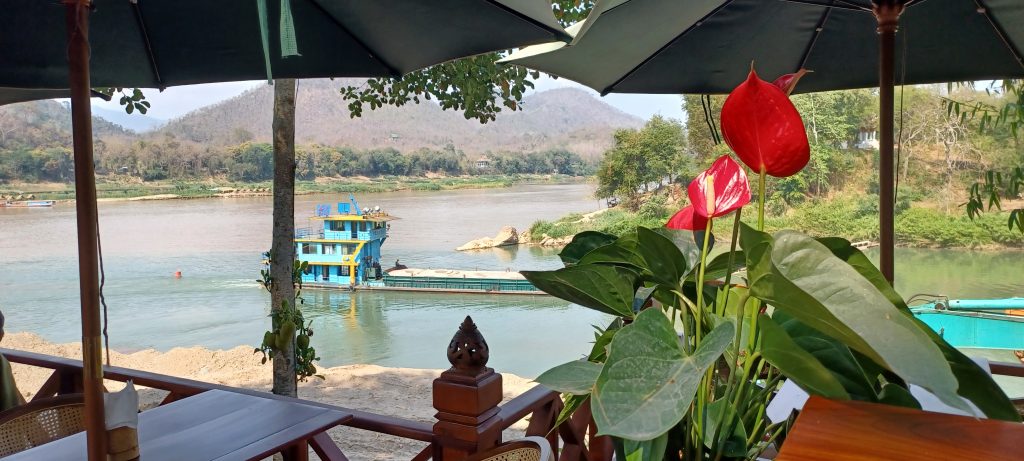
Eventually ease myself off the chair, pay the bill, and wander along the Khan tributary hoping to see the bamboo bridge marked on my tourist map. However dredging is going on all the way along the river and no bridge is in evidence. Thus, I turn 90 degrees up a shady side-street and cross the peninsula to the Mekong again. More old wooden houses in the French colonial style on these shady streets. No modern high rises here. Not permitted to build them due to the city’s World Heritage status. I had intended to climb the 328 steps up Phousi hill to the wat on top and savour the views from there but, being as how it is still mighty hot, I decide to postpone this entertainment until the cool of the evening. For now, I admire the mountain from below then hire a tuk-tuk back to the hotel.
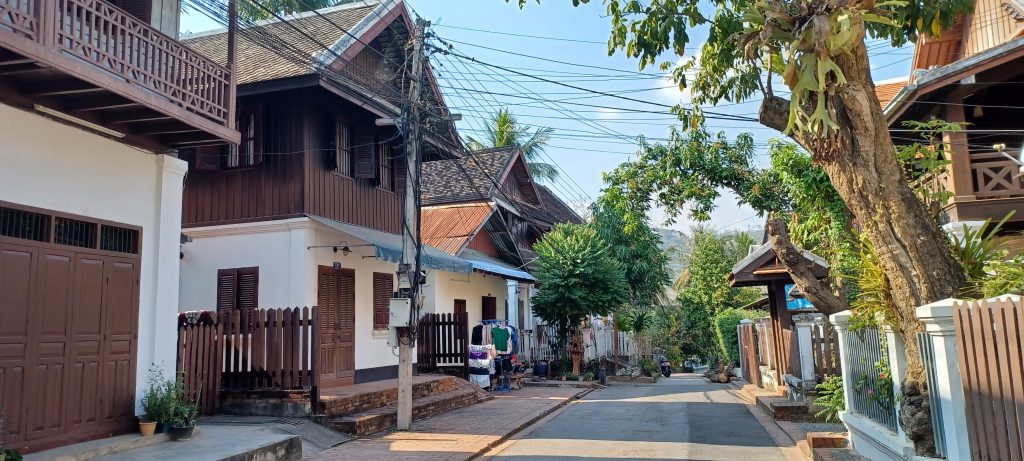
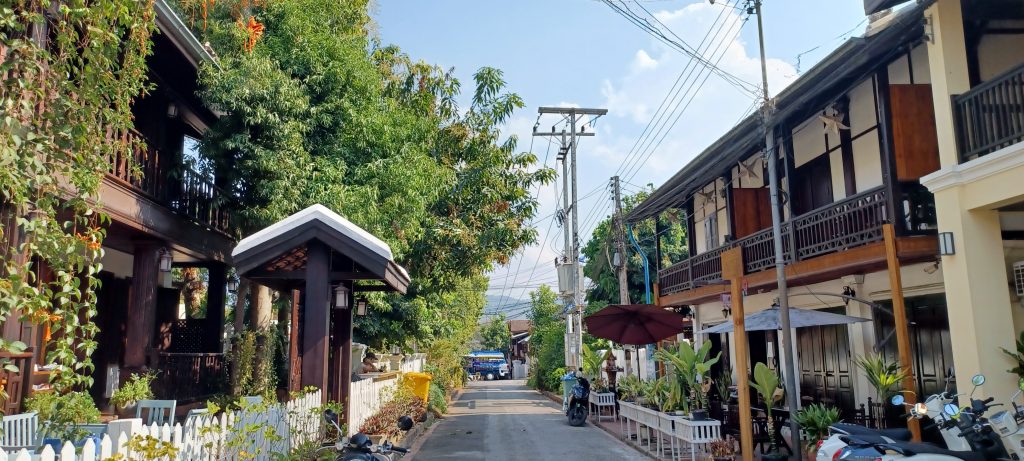
One more night here. Neglected to climb Mount Phousi, I think to myself, as I toast white sliced bread for breakfast. I hunt for tea bags but they seem unavailable so I raid my existing emergency supply – in my pocket just in case. Good job. Have to beg for milk. Water melon provided but only if you get there quickly enough. Omelettes are made on demand though.
Wat That Luang
Just time before leaving to take a quick walk to see a temple close by the hotel, the gorgeous Wat That Luang, the Monastery of the Royal Stupa, where royal cremations once took place. This included that of Laos’ last King, Sisavang Vong, he whose statue is in the National Museum and whose golden carriage bore him here from Wat Xieng Thong. Anyway, this wat is a paradise of tranquillity and beauty. No other tourists.
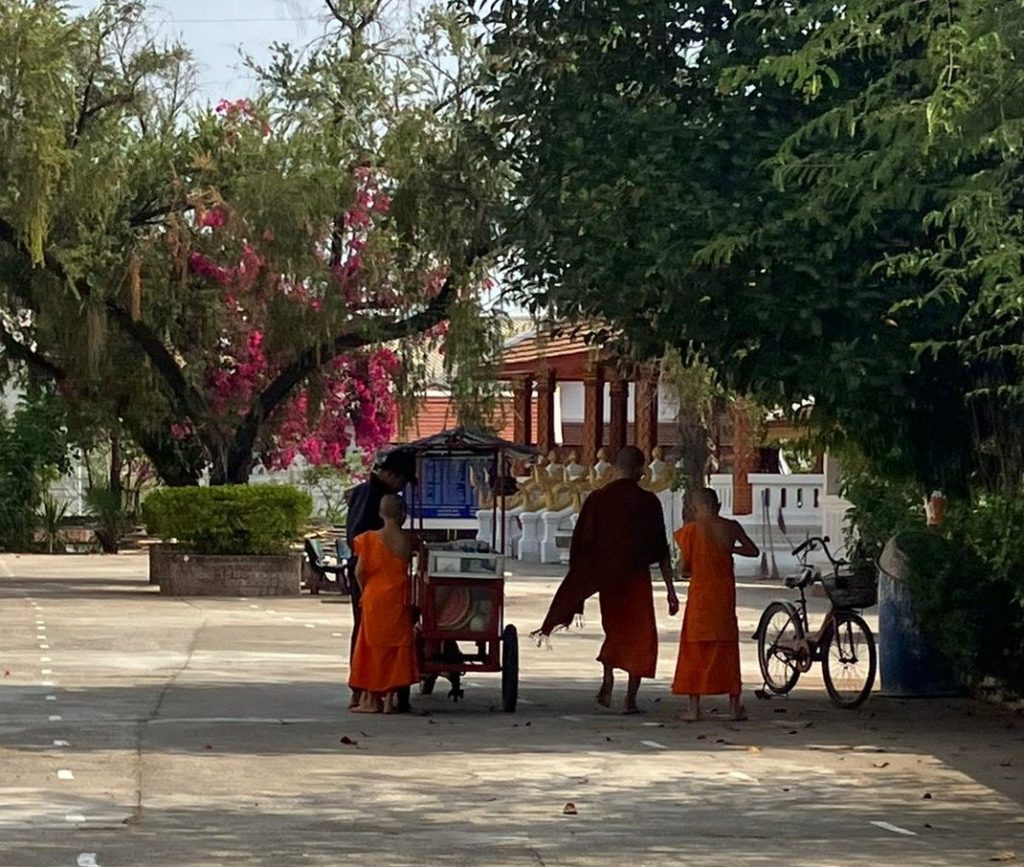
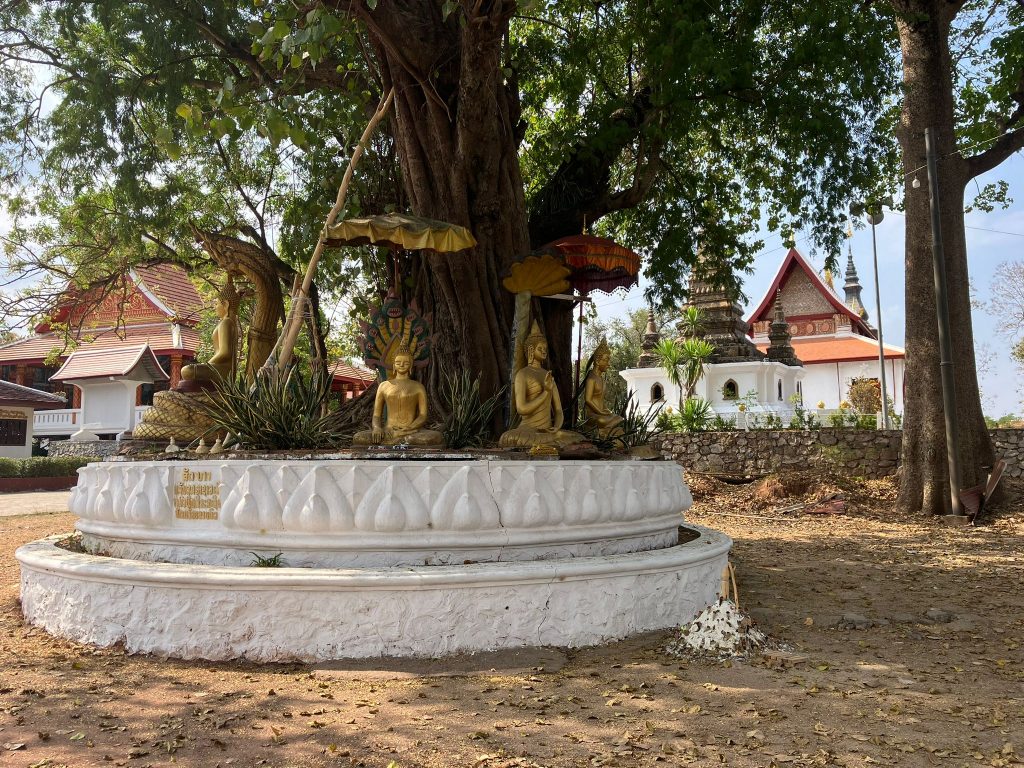
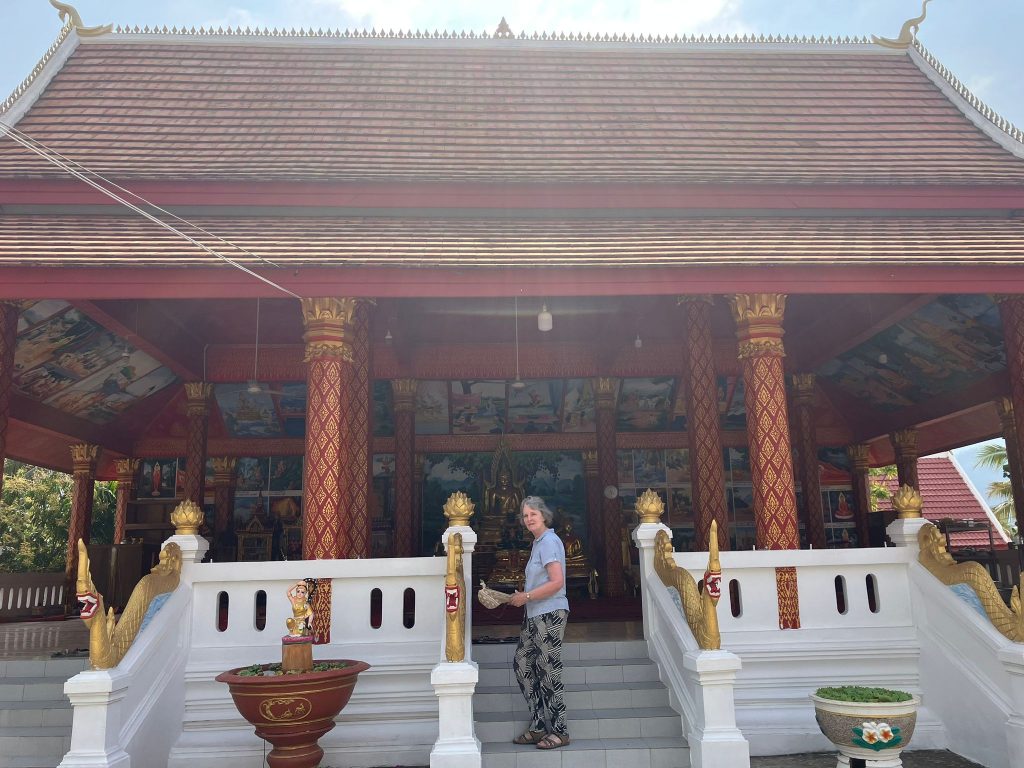
So now we leave the Mekong River and head to the train station. The station was funded by the Chinese, I gather. Staggering building. Massive, airy and clean. Board the train. Destination: Vang Vieng.
Vang Vieng
It is less than an hour from Luang Prabang to Vang Vieng, the backpackers’ paradise, where several young people were poisoned with free alcohol fairly recently.
Not a bad hotel with views of the distant mountains to the west. Late afternoon. Head up to the top level where there is a small swimming pool and Somersby cider on offer. Many of the group are relaxing here, contentedly contemplating the sunset. Balloons are floating downwards in front of spectacular karst rock outcrops and go-kart paragliders are flitting about above like flying ants. I will be up there with them tomorrow.
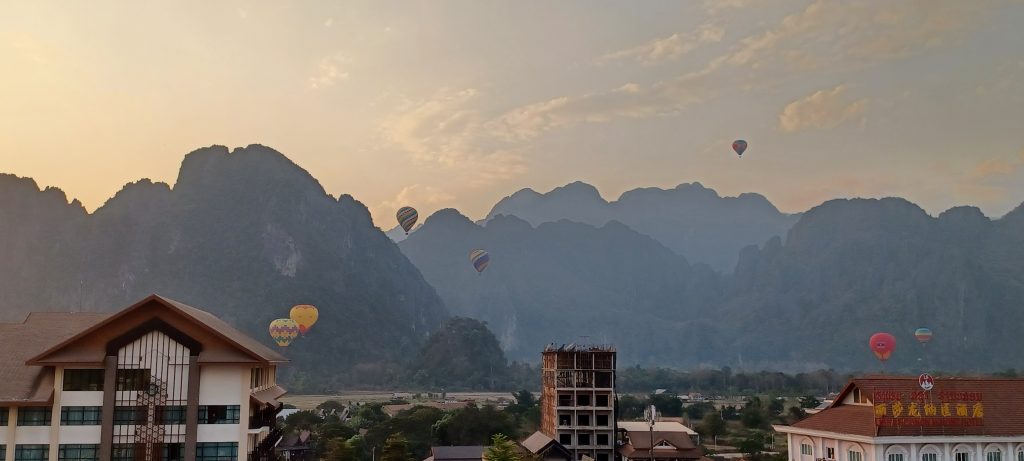
Shame to leave this eye catching spot right now but a group dinner close by the hotel has been arranged. Not wildly exciting fare. Soggy noodles.
Breakfast. No milk. One of our party, a Brit like me, who requires his standard ‘English Breakfast’ tea, has found a 7/11 shop and bought some milk. With admirable generosity, he donates some to me. Breakfast includes tiny pancakes with strawberry jam. More white bread. Afterwards, I head off for a stroll about town with a couple of others. Relaxing jaunt in slow time.
Come across a bamboo bridge over the river. At least, the hand rails are bamboo, the crosspieces of some kind of hard wood. Uprights of spindly branches of some tree or other. Some holes in the planking and shaky bits. Gingerly tread the boards.
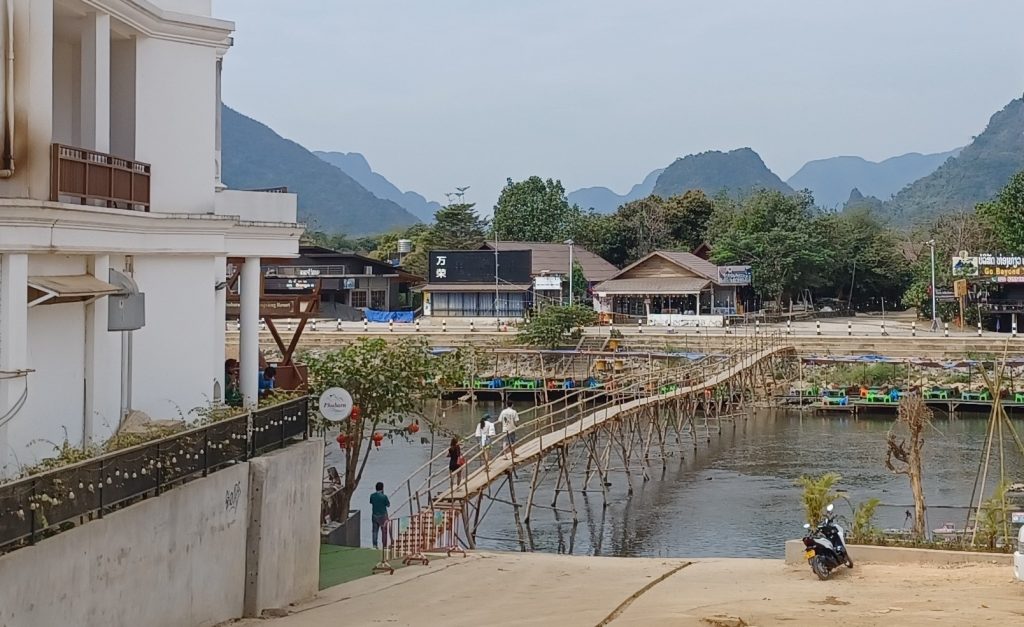
Wander along the other quieter side of the river. Many canoes with outboards poodle up and down. I notice that fishermen have strung a net between two of these canoes, hoping to catch an elusive fish or two. A few birds flit about. Swallows and sparrows mostly. And there are many chalets for tourists, and cafés to catch those thirsty adventurers who float down the river on the inner tubes of tractor tyres. Fun, no doubt. Did that in my youth. We come to another bridge over the river. This bridge is used by bicycles, motor scooters of all sorts, as well as pedestrians. Two metal strips on the bridge enable the bikes to ride over it more easily. Another rickety experience.
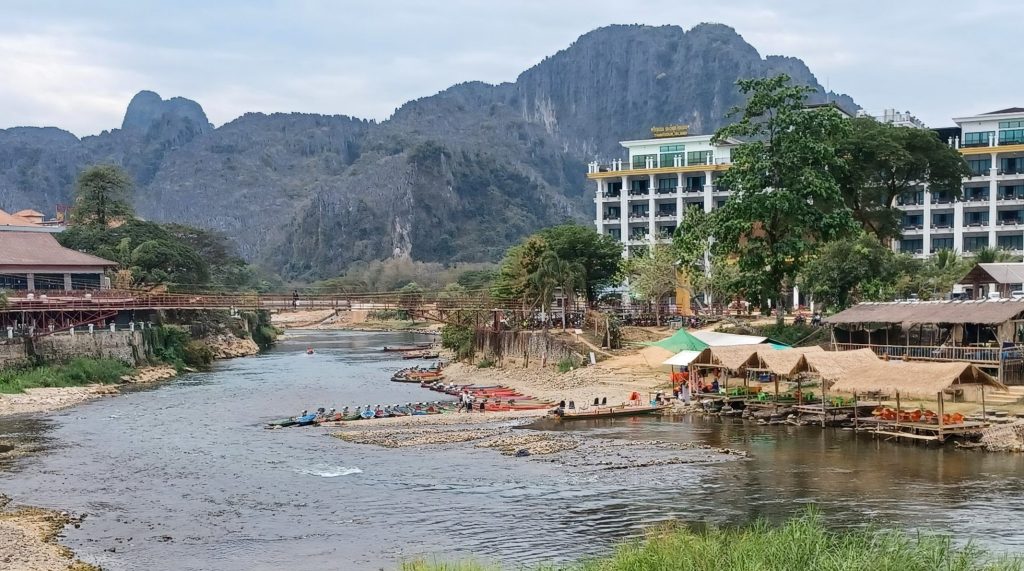
On the other side of the bridge we find a café. Order various juices and beers. Cool off a bit before wandering back to the hotel.
Go-kart Paragliding, Vang Vieng
Time now to participate in what was advertised as the ‘Vang Vieng Adrenaline Bundle’. I arrive with a couple of others at an extensive lumpyish flattish field. Go-kart paragliders are whizzing about above. These are 3 wheeled karts, each with a big propeller on the back, and attached to a parachute. I had opted to take a flight. Wearing ear defenders, red jumpsuit and helmet I am strapped onto the front of one of these karts and am soon racing over the ground with my pilot sitting behind.
But not before, at the last moment, a long selfie stick, the length of a ski pole, is shoved in my hand with which to video myself. Eh? No thanks. But it is too late. The parachute, which was laid out on the ground behind, lifts off and so do we. But I am forced to fiddle with the pesky selfie stick for a few minutes instead of surveying the scenery. Nonetheless, there is a stupendous view over the Nam Song flowing below, streets and houses and hotels beginning to turn on their lights. And the sun beginning to set behind the mountains. Other gliders are buzzing about all over the place. The flight is over in a fleeting fifteen minutes and we land bumpily. Novel experience. Not as sublime as a balloon flight (see Egypt, Part 2), but it got the adrenaline going.
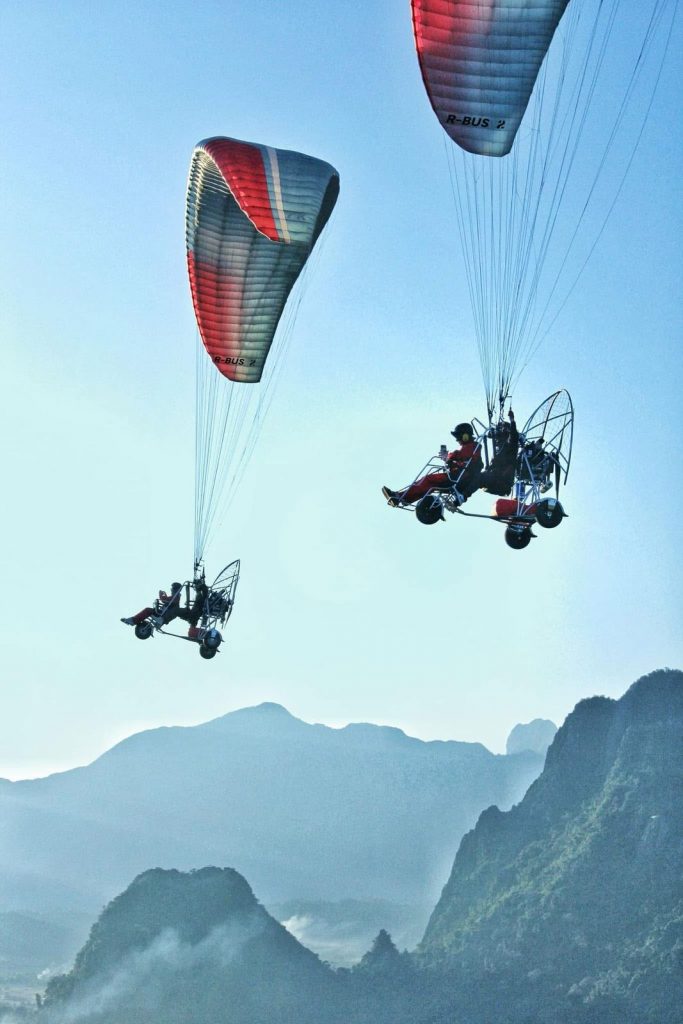
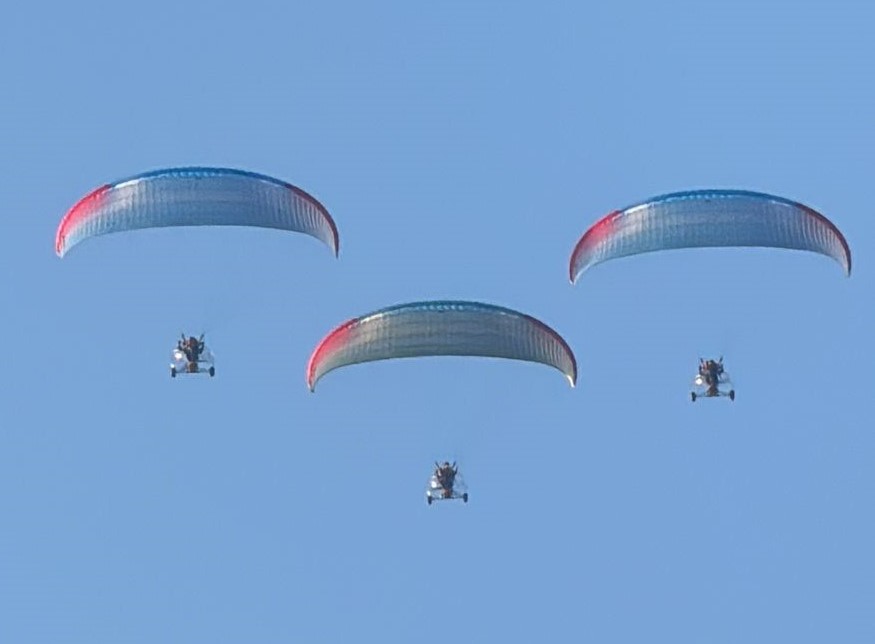
Back on terra firma, I watch other paragliders coming in to land. Some are in formation. They look like mosquitos homing in for the kill. I make my way to the building to divest myself of the red jumpsuit and hand in my selfie stick, lacking a video clip for the staff to sell to me. Better luck with the next customer.
Back to the hotel. Our CEO had told us “I will be meet you at Elephant Crossing at 7. OK”. OK. We converge for a group dinner in the Elephant Crossing Roof Top Bar at the desired time. Splendid location high on the rooftop with the flickering lights of Vang Vieng below. Views all over the town and a laser beam bearing pink and purple lights darts all over the place. Paragliders are still up there in the darkness with their lights on. Hear their motors. No stars tonight. Ominous black clouds. Dinner is conveyed to us by cheery ladies. I opt for pesto and eggplant pasta, versus noodles, accompanied by Somersby apple cider.
Vientiane
Raining. Vang Vieng’s spectacular mountains are obscured but it is 19 degrees, which makes a welcome change from the excessive heat. We take a coach to Vientiane. I have time for reflection. Interesting tour group. Range of characters. Invariably get a good mix. Some loud, some quiet, some demanding, some laissez-faire, the organised and the faffers. As for the tour itself, lots of variety, rather too many optional extras and a vast amount of organisation for the CEO to try to accommodate the needs of fifteen participants ‒ from young thirty somethings to older seventy somethings. He manages it all with infinite patience.
Arrive at the hotel too early to check in. No city tour included as usual so we arrange our own, although a tuk-tuk is booked for us. Seven of my fellow travellers plus self pile into the back of this vehicle in the rain. The waterproof sides are down but these do not stop the lashing rain from seeping in. Those at the back drew the short straw.
COPE visitor centre
First stop close by is a visit to the COPE visitor centre where we learn about the bombs that the Americans dropped on Laos between 1964 and 1973. Not something that is generally known about. According to the information given, two million tonnes of ordnance were dropped during this time, much of which did not explode and remains in situ all over the countryside. Some cluster bomblets are on display and the huge cases they were dropped in. Bit sobering. We watch a video showing how the local people have been affected by the bombing, how they are still clearing up after it five decades later. Some still collect bits of metal for scrap using metal detectors and lose limbs when unexploded ordnance detonates. Lot of prosthetic limbs on display and bits of shell cases.
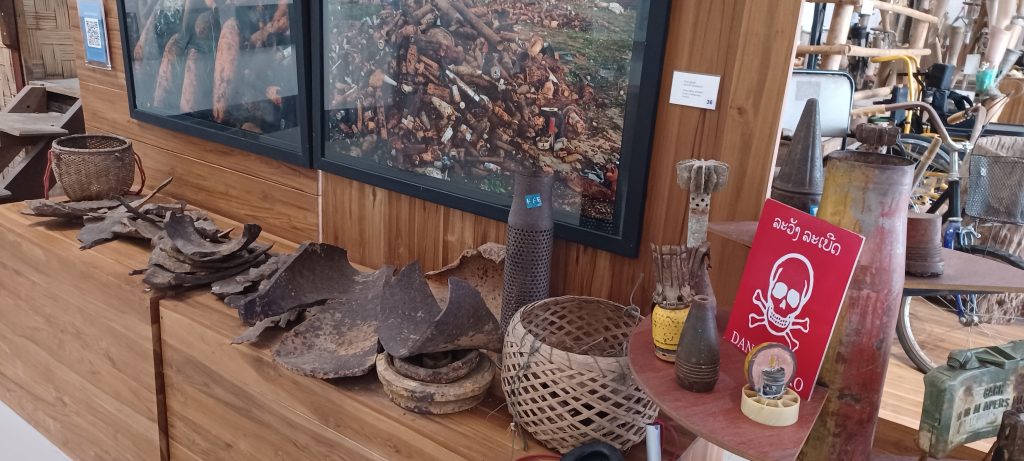
Buddha Park
File back into the tuk-tuk lurking outside. “You mustn’t miss the Buddhas in the Park”, our CEO had advised us before we left. OK. We head thither. It transpiring that the Buddha Park is twenty five kilometres from the city centre, the overloaded tuk-tuk crawling and phutting its way with its soggy occupants, I begin to lose my sense of humour, as do most.
Some forty five minutes after piling in, we pile out, aching and damp from being cramped in the tuk-tuk. Head to the ticket booth and pay many thousands of Lao kips for the privilege of viewing a smallish park full of Buddhas in various poses. The park is known by the locals as Xiengkuane Buddha Park, ‘Spirit City’. Built by a monk in 1958, who studied Hinduism as well as Buddhism, the park holds a variety of Hindu gods as well as Buddhas. About two hundred of them made out of reinforced concrete I gather, including a huge forty meter long reclining Buddha and a giant pumpkin with a demon’s mouth, through which one can venture into the unknown if one desires. All a bit weird and wonderful. Scuffle between one sculpture and the next between the downpours, occasionally sheltering under a frond or two.
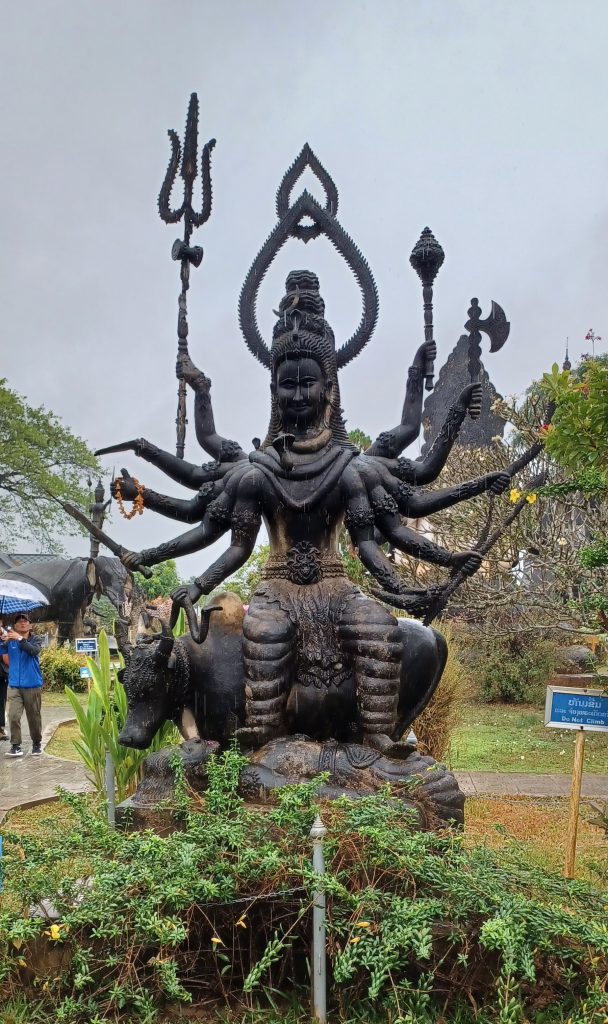
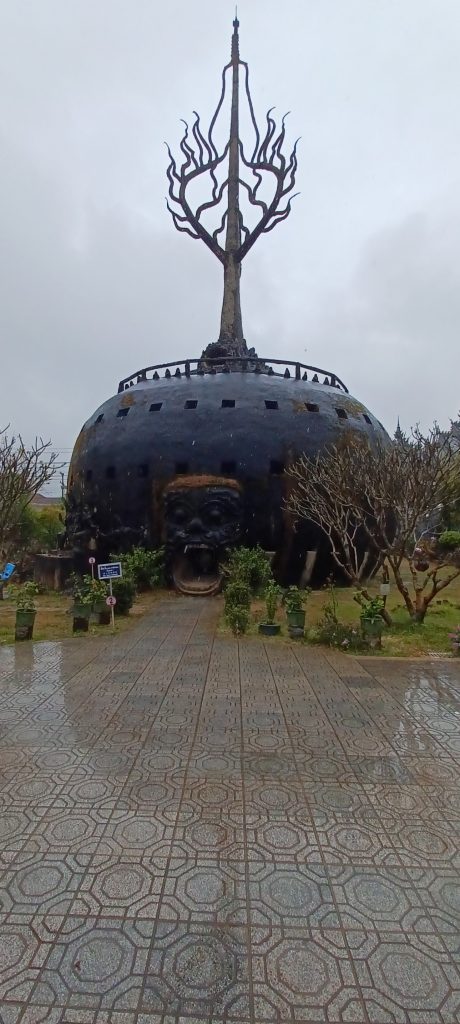
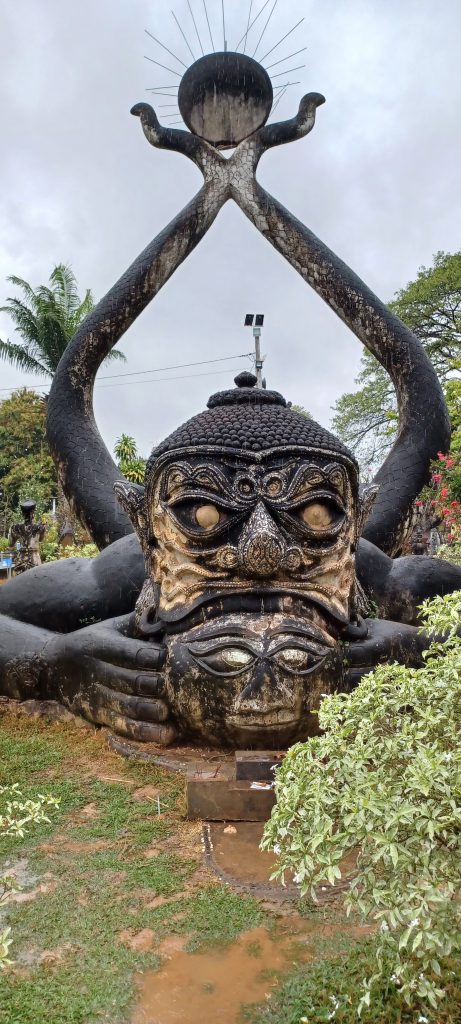
Spend some while perusing the reclining Buddha, looking none too serene in the inclement weather. Resting his head on his hand, he appears decidedly peeved.
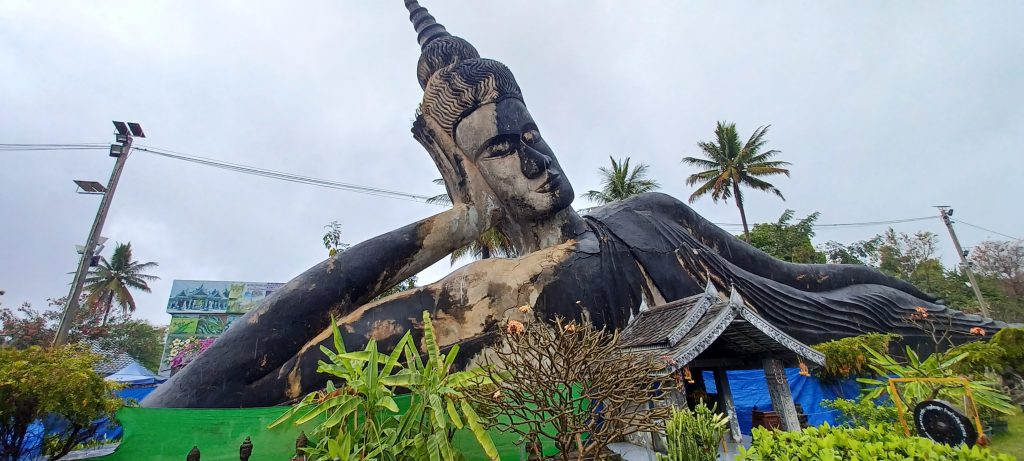
Phra That Luang
After returning damp and cold and less than sprightly from the Buddha park, we are tuk-tukked to a stunning temple complex in the city. This is the Phra That Luang, and the great golden stupa, forty five metres high, is the national symbol of Laos and the country’s most sacred site. The original smaller stupa here was erected to host a piece of Buddha’s breastbone. The pinnacle is covered in gold leaf, while the remainder, along with the surrounding thirty smaller stupas, are all painted gold. The stupa has undergone various reconstructions after suffering damage in various conflicts.
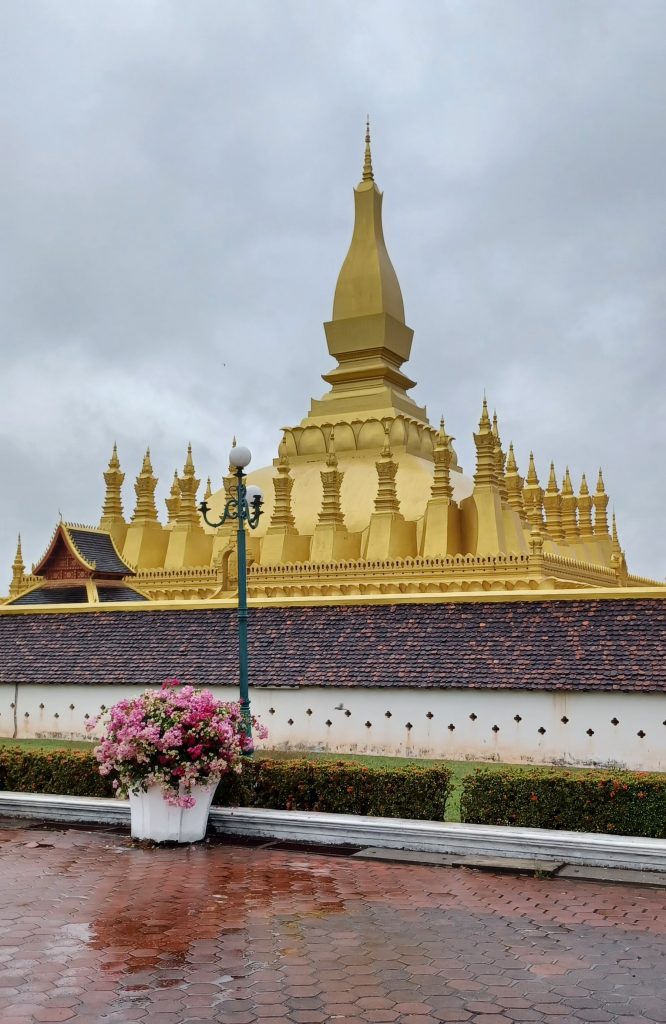
I wander round the grounds viewing temples and pavilions, statues and a large reclining Buddha, also covered in gold leaf. Looks happier than the concrete Buddha in Buddha Park, I have to say. Beautiful statue actually.
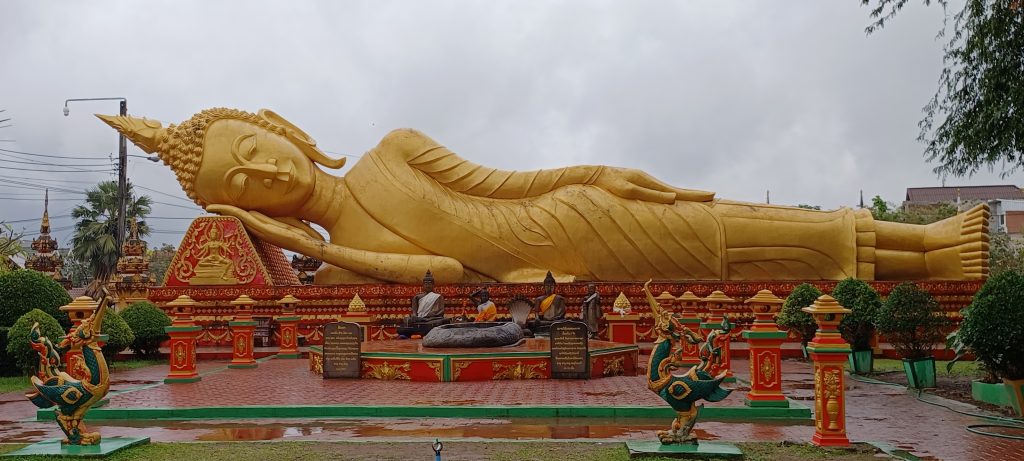
The now familiar nagas and other mythical figures guard entrances, as we saw in Luang Prabang. Roosters peck about and screech their afternoon calls, monks enter temple doors. Superb painted ceilings. Magnificence everywhere one looks. Still raining.
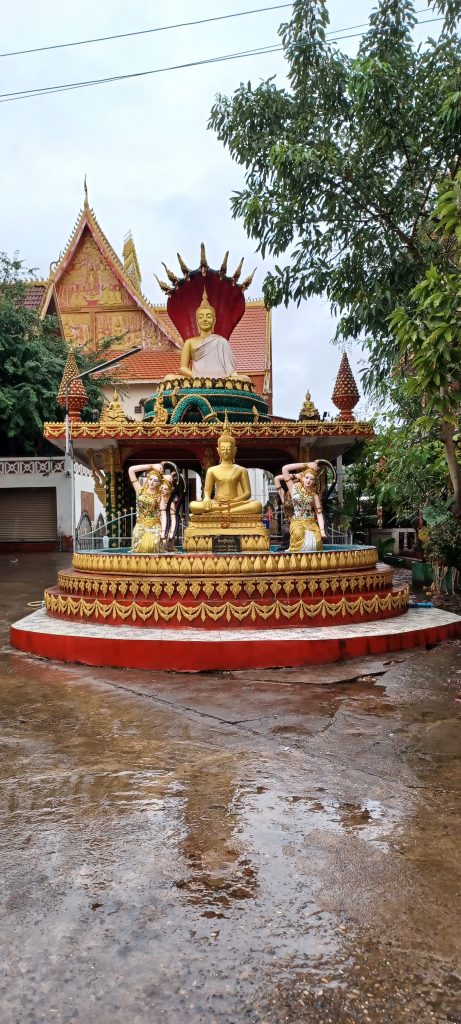
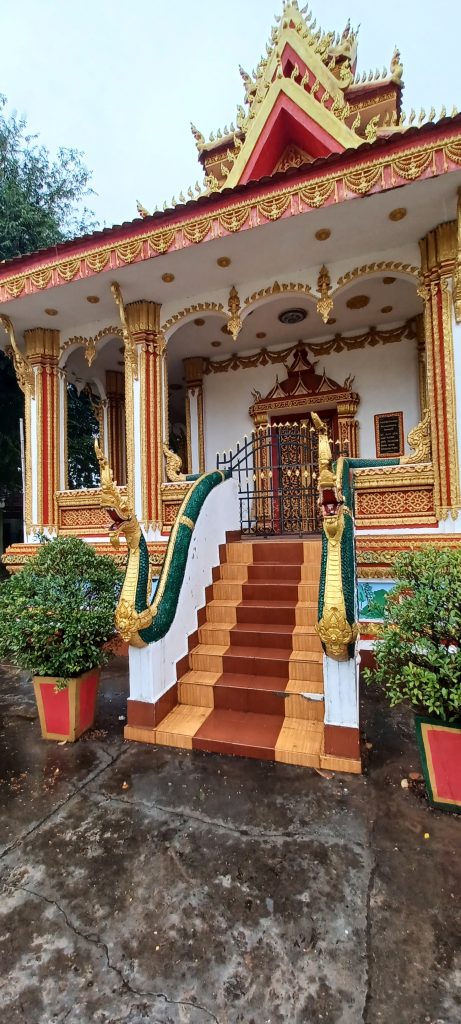
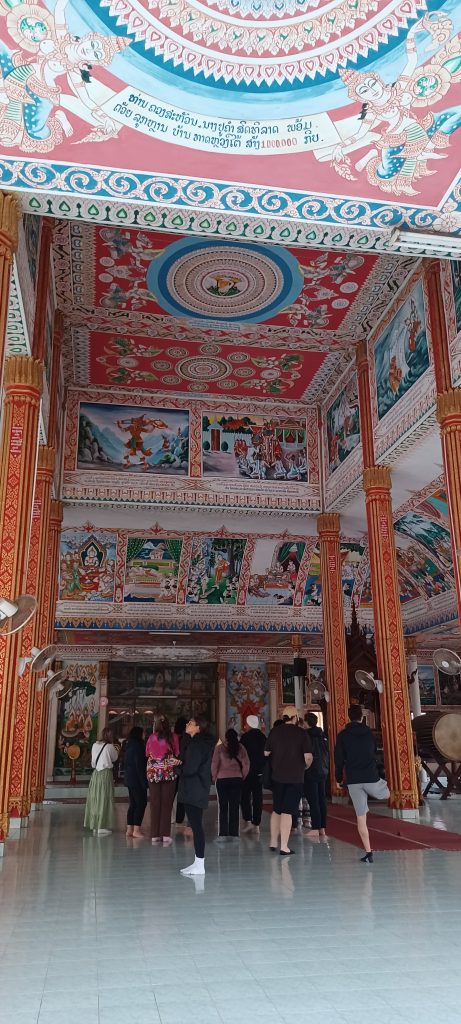
Not enough time to view this astonishing temple complex. My favourite so far. The rain enhances the colours. Tuk-tuk to the hotel. Just time for tea before dinner. Kettle lid falls off as I brew up in my room. I have not only a stash of tea bags in my backpack but milk too. Had been yearning for a hot cuppa for three hours. Need to shake off this English habit but, right now, tea hits the spot.
Group dinner. Hop across puddles on the way to an eatery some distance from the hotel. Rain has eased though. We are welcomed into an attractive restaurant with black and white framed photographs of old Vientiane on the wall and red wine on offer. Splendid. Not had any of this nectar for some weeks. Feel a lot more chirpy, even though the food itself is fairly nondescript. A fun evening. Good because it is our last night in Laos. Marred slightly by ferocious mosquitos in the hotel bedroom. Well, you win some, you lose some. All part of the experience. But, on balance, a stimulating and eventful trip in this captivating country.

Leave a Reply